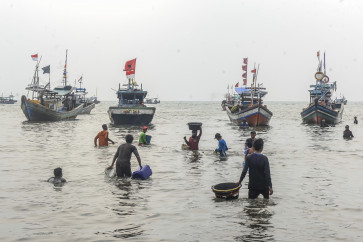Popular Reads
Top Results
Can't find what you're looking for?
View all search resultsPopular Reads
Top Results
Can't find what you're looking for?
View all search resultsBolu: A Portuguese contribution to Indonesian cuisine
When we talk about the Portuguese art of baking in Indonesia, bolu are by no means “the last of the Mohicans”
Change text size
Gift Premium Articles
to Anyone
W
hen we talk about the Portuguese art of baking in Indonesia, bolu are by no means “the last of the Mohicans”. I must also honor several other snacks and cakes that have stood the test of time since the Portuguese first came to Indonesia several hundred years ago.
Bolu Genjer
Ingredients vary from the luxurious to the very simple in Manadonese mainstays, consumed at any time of day whenever hunger pangs are felt between meals. Pastels, for example, were brought by the Moors to the Iberian region centuries ago, and so in fact they are of Middle Eastern origin. But then the Portuguese and Spaniards brought meat-filled fried dough parcels to the Spice Islands — where they stayed and have remained popular until now.
Panadas are a Portuguese-influenced delicacy found in northern Sulawesi, based on empadas (from Portugal) and empanadas (from Spain), which use short-crust pastry. The northern Sulawesi version uses dough to make the delicious tuna-filled panadas.
Whether made with pastry or dough empadas, empanadas and panadas are really mouthwatering snacks. My recommendation: try these Indo-Portuguese or Indo-Iberian delicacies that have been popular here for centuries!
In his foreword to Portuguese influence in Indonesia (written by Dr. Antonio Pinto da Franca, the Consul of Portugal to Indonesia in the late 1960s) Professor Sartono Kartodirdjo from the prestigious Gadjah Mada University in Yogyakarta notes that a Portuguese chronicler named Joao de Barros once stated “Time will not destroy the religion, customs and language that the Portuguese have implanted in these lands.”
The honorable Dom Joao forgot to mention one important thing, namely the Portuguese culinary influences, which remain evident here to this day.
According to the book, Portuguese cooking was first introduced to Indonesia at the beginning of the 16th century when Antonio de Abreu and Fransisco Serrao sailed along the coasts of the islands Java, Bali, Flores and Banda.
Francisco Serrao, the commander of one of the boats belonging to an expedition sent by Alfonso de Albuquerque, was shipwrecked and rescued by the people of Hitu on the island of Ambon.
Over the course of time Serrao became the ultimate counselor of the sultan of Ternate, and married a woman of Javanese origin who bore him two sons. Dom Francisco died in Ternate in 1521.
This period saw the beginning of 150 years of close contact between the two regions, which had clear influences on the culinary traditions in Indonesia also. During this time the bolo (meaning cake in Portuguese) became one of Indonesia’s favorite cakes, and are still referred to as bolu in Indonesia today.
It has been assumed that a Portuguese “dom” who was missing his country’s superb pastries tried making them here, or perhaps gave the recipe to his local helper (or wife). The recipe must have been a hit, because now a multitude of bolo (bolu) enrich Indonesia’s culinary repertoire — there are even bolo recipes with vegetables in them.
As for the original Portuguese bolo, bolo rei and bolos grandes were probably the cakes brought to the eastern islands of the archipelago back in the day. According to The food of Spain and Portugal. The complete Iberian Cuisine by Elizabeth Lambert Ortiz, kings day bread is a special holiday bread baked in Portugal to celebrate Jan. 6, the Epiphany or the day of the Three Kings, which is the principal day for gift-giving (especially to children) because (according to the bible) on that day the three wise men came to visit the infant Jesus bearing gifts for him.
The Food of Spain and Portugal goes on to mention that this special cake is baked in a mug and contains either a bean, a coin or a small figurine. The bolo rei tradition varies from country to country; in Portugal if you find a coin in your bolo you are penalized, but in Spain it means you will have good luck all year round. The Portuguese bolo rei is the richest of all versions, and has lots of fruit and nuts.
The bolo traveled with the Portuguese traders, and wherever they anchored a version of a bolo recipe has remained available to this day.
Throughout Indonesia there are countless bolo variants, and not just cakes but also savory breads. These are enjoyed throughout the day because bolu are sold daily, not only by the itinerant kue – kue women but also at wet markets as an item of the traditional jajan pasar array, as well as in better cake shops and even in the deluxe ones.
Some bolu have even found their place at ceremonial events and in many a pre-wedding ceremony kue bolu are presented as hantaran (presents to the future bride and groom).
Bolu ingredients have also become varied and no longer rely on wheat flour, but rice flour is also used, for example in bolu brai from the island of Sumbawa. Bolu brai is not baked but steamed.
Another regional bolu that still uses wheat flour, and which is also steamed, is bolu kukus (or roti kukus in Javanese. It is interesting to note that in Javanese bolu is sometimes still translated as roti or “bread”.
West Sumatra gives its bolu a Middle Eastern touch, calling it bolu koja (koja meaning Arabs or Arabian). The West Sumatran bolu koja has thick coconut milk added to the batter.
Bakers in Timor Leste and Nusa Tenggara Timur have bolu koja lunak, meaning soft-textured bolu koja, which are made with nearly the same ingredients as their West Sumatran cousins, but use hen eggs instead of the duck eggs.
Another delicious bolu is one of Palembang’s specialties. This bolu is heavily spiced with ground cinnamon, vanilla, ground cloves and ground cardamon.
Bolu mutiara (pearly bolu) is the eastern islands’ version and contains sago, grated fresh cassava, vanilla and salt. No doubt one of the well known bolu cakes, however, is bolo delicia de caramelo from the former East Timor (now Timor Leste), which is never absent at traditional wedding feasts and intimate family gatherings in the eastern islands.
Last but not least are several bolu containing vegetables. Bolu genjer from West Java is worth a second bite. Genjer, a water vegetable often found growing wild on fishponds or in muddy soil has been a popular stir-fry ingredient for a long time. Many people eat genjer a least once a week because it is a useful source of iodine for people living in mountainous areas. To add a touch of extravagance, try adding juicy freshwater shrimp to the stir fry!
Back to bolu genjer, this is a special bolu made with nutritious vegetables and crabmeat and is delicious! Wash and pick 100 g genjer (available at supermarkets). Stir fry 3 cloves of finely chopped garlic in 2 Tbs margarine until aromatic, then add 75 g chopped crabmeat, and season with ½ tsp salt (or to taste). Beat five hen’s eggs, 175 g ground sugar and 1 tsp TBM (softener, also available at supermarkets) until whitish. Add 225 g sifted riceflour, 75 g sifted glutinous riceflour (both available at supermarkets) and ½ tsp salt. Pour in 200 ml thick coconut milk. Continue mixing until well mixed.
Grease a suitable baking pan with 2 Tbs margarine and dust with 2 Tbs flour. Add alternately 30 ml batter and 2 Tbs stir fried genjer and crabmeat mixture until finished. Bake or steam over medium heat until done. (Makes 20).










